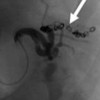Interventional Radiology in Acute Pancreatitis: Friend or Foe?
Abstract
Context Peripancreatic fluid collections are known complications of pancreatitis. The majority of fluid collections can be drained percutaneously under radiological guidance. Although radiological percutaneous drainage is regarded as safe, here it resulted in catastrophic haemorrhage from the colon due to an iatrogenic injury. Case report We present a case of a 70-year-old man who presented with acute alcohol-related severe necrotizing pancreatitis and an associated massive peripancreatic fluid collection. The drainage of this collection was attempted under computed tomography (CT) scan guidance. During the procedure the splenic artery and the splenic flexure of the colon were inadvertently damaged leading to life threatening per rectal bleeding requiring emergency angiographic embolisation of the splenic artery. Conclusion Radiological drainage of peripancreatic fluid collections is generally regarded as having lower rates of complications compared to surgical necrosectomy. However, in this case it leads to a life threatening per rectal bleed requiring emergency splenic artery embolisation.
Downloads
References
Maher MM, Lucey BC, Gervais DA, Mueller PR. Acute pancreatitis: the role of imaging and interventional radiology. Cardiovascular Interventional Radiology. 2004;27:208-225.
Brun A, Agarwal N, Pitchumoni CS. Fluid collections in and around the pancreas in acute pancreatitis. Journal of Clinical Gastroenterology. 2011;45(7):614-625.
van Baal MC, van Santvoort HC, Bollen TL, Bakker OJ, Besselink MG, Gooszen HG. Systematic review of percutaneous catherter drainage as primary treatment for necrotizing pancreatitis. British Journal of Surgery. 2011;98(1)18-27.
Bergman S and Melvin WS. Operative and nonoperative management of pancreatic pseudocysts. Surgical Clinics of North America. 2007;87:1447-1460.
Heider R, Meyer AA, Gaianko JA, Behrns KE. Percutaneous drainage of pancreatic pseudocysts is associated with a higher failure rate than surgical treated in unselected patients. Annals of surgery. 1999;229:781-789.
Segal D, Mortele KJ, Banks PA, Silverman SG. Acute necrotizing pancreatitis: role of percutaneous catheter drainage. Abdominal Imaging. 2007;32:351-361.
Al-Habbal Y, Christophi C, Muralidharan V. Aneurysms of the splenic artery - A review. The Surgeon. 2010; 8(4): 223-231.
Goldberg RF, Maley W, Kennedy EP, Yeo CJ, Lavu H. Giant splenic artery pseudoaneurysm. Journal of Gastrointestinal Surgery. 2011; 15: 1063-1066.
Flati G, Andrén-Sandberg A, La Pinta M, Porowska B, Carboni M. Potentially fatal bleeding in acute pancreatitis: Pathophysiology, prevention, and treatment. Pancreas. 2003; 26(1): 8-14.

Copyright (c) 2014 Maziar Khorsandi, Kevin Beatson, Scott Dougherty, Ian Zealley, Christoph Kulli

This work is licensed under a Creative Commons Attribution 4.0 International License.
As a member of Publisher International Linking Association, PILA, iMedPub Group’s JOP follows the Creative Commons Attribution License and Scholars Open Access publishing policies. Journal of the Pancreas is the Council Contributor Member of Council of Science Editors (CSE) and following the CSE slogan Education, Ethics, and Evidence for Editors.